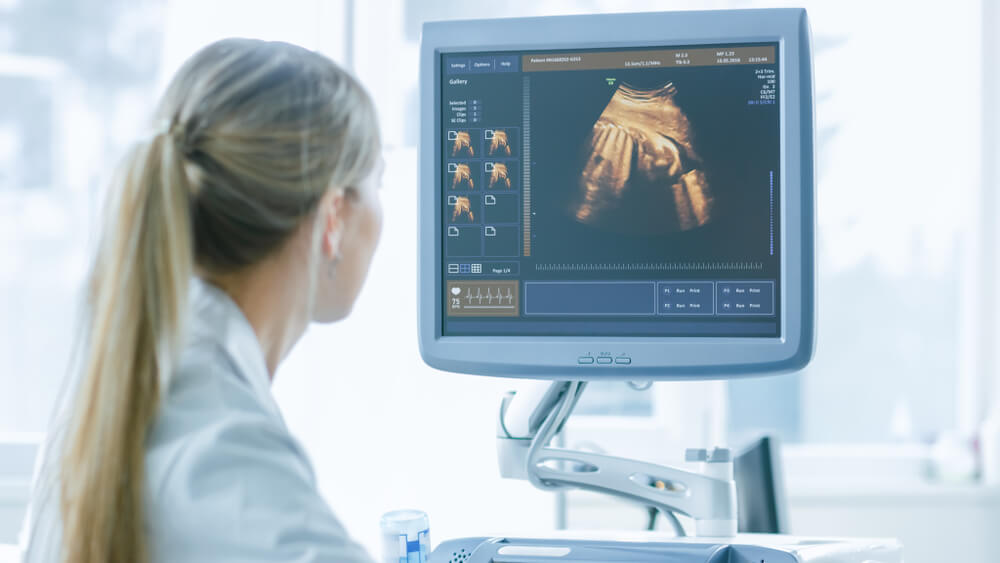Saline ultrasound used for analyzing the uterus interior is called a sonohysterogram (SHG). There are other names for sonohysterography, including hysterosonography, saline-infused sonography (SIS), and SIS ultrasound. When the saline sonogram is specifically focused on fallopian tubes, it could also be called sonosalpingography. This saline infusion ultrasound is essentially done when the patient shows potentially abnormal uterine changes and symptoms, when testing fertility, or before the IVF procedure.
How the Saline Ultrasound Works
Performing an SIS ultrasound requires the placement of a thin tube into the cervical opening. Saline infusion is then slowly inserted through the tube in order to slightly spread the uterine walls. At the same time, the technician inserts an ultrasound wand, known as the transducer, to assess the walls and the shape of the uterus. The transducer sound waves bounce off the uterine walls and then get recorded as echoes. These echoes translate to images of the uterus on the monitor that the doctor/technician can see.
It’s possible to get transvaginal ultrasound without inserting saline, but a saline sonogram actually provides a better and more accurate assessment of the uterine condition. With the uterine walls slightly spread out, it’s also easier to spot and record potential issues.
Your doctor might suggest a sonohysterogram in case of the following:
- Unusual menstrual cramping
- Either unusually light or heavy period bleeding
- Spotting in between periods
- Bleeding after menopause
- Before the IVF procedure
- Recurring miscarriages or infertility
- Pain and pressure in the pelvic area
Sonohysterogram can pinpoint abnormalities in the shape of the uterus and congenital abnormalities such as the uterine septum, fibroids, polyps, scar tissue, unusual endometrial growths, and how thick or thin the uterine wall and endometrium are in general.
Preparation for the SIS Ultrasound

The best course of action would be talking to your doctor so that they can explain the best preparation practices. In general, an SIS ultrasound should be performed after the period but before ovulation. That way, there’s no risk of performing the test early in the pregnancy.
In case you don’t menstruate, the doctor might prescribe some meds to induce it. If there’s a higher infection risk, they might also prescribe antibiotics that have to be taken prophylactically.
It’s generally recommended to take some over-the-counter pain relievers about half an hour before the scheduled ultrasound. The most common pain reliever, in this case, is 400 mg of ibuprofen, but if you can’t take it, make sure to inform your doctor about it so that they can suggest a suitable alternative.
What to Expect During the Procedure?
While you may be used to going in for an ultrasound with a full bladder, SIS ultrasound requires a completely empty bladder. Therefore, make sure to go to the restroom before the procedure.
Before you lie down on the exam table, you’ll have to remove your clothes from the waist down. Of course, the technician will help you with this. Lie on your back, with bended knees and/or heels in the stirrups.
In many cases, before the hysterosonogram, you will get a transvaginal ultrasound without saline infusion. Afterward, the doctor will disinfect the whole area with a cotton swab. There’s nothing painful about this, but you might feel a bit of pressure.
The next step involves the insertion of the thin tube, i.e., a catheter that goes into the cervical opening. A small balloon filled with water or air next to the catheter will hold it in place. The doctor/technician will proceed to insert the transvaginal ultrasound wand and push saline through the tube. Saline goes through the fallopian tubes and into the uterus. As the saline fills up, the transducer takes pictures of the uterine cavity.
Aside from the hysterosonogram, the doctor might also want to do the trans-abdominal ultrasound. This is a typical type of ultrasound where the gel is applied to the abdomen, and another transducer is used to move over the gelled area to take images.
Once the hysterosonogram is completed, the doctor/technician will remove the ultrasound wand, catheter, and balloon. It’s possible to get some saline leakage when you stand up. On average, the entire saline ultrasound procedure doesn’t take longer than 15 minutes.
What to Expect After the Procedure?
There’s a chance of feeling slight cramping post SIS ultrasound, but that’s nothing to worry about. If the only procedure you had was a saline sonogram, you can easily resume your daily activities right after it. Your regular menstrual pain relief meds should do the job, in this case, just fine.
It’s also possible to experience some saline leakage 24-48 hours after the ultrasound. Really light spotting may also happen. It would be best to use and bring with you menstrual pads to feel comfortable. However, you shouldn’t use tampons after sonohysterogram at least for a couple of days to avoid infection risk. Also, it’s important to refrain from engaging in sexual intercourse for at least two to three days after the ultrasound for the same reason. If you also had some other procedures and exams in conjunction with SHG, discuss the recovery process with the doctor.
However, if you happen to experience any of the following symptoms, make sure to contact your doctor as soon as possible:
- Pain and cramps that last longer than a day
- Bleeding that’s heavier than just spotting
- Strong pain sensation on the day of the ultrasound
- Fever
- Other symptoms that you find unusual and worrisome
What About the Results?

Sonohysterogram is performed either by the doctor or the technician. They might be able to provide you with some information as they get the images on the monitor. However, you’ll need a follow-up appointment with the doctor for full results reading.
If the SHG results come back normal, the doctor may suggest the following steps, depending on the reason why the procedure was ordered in the first place:
- Give approval for the IVF procedure
- Come up with a fertility plan and treatment
- Suggest further tests
In case the SHG results come back showing some abnormalities, the following steps will highly depend on the nature of these abnormalities. For instance, if the saline ultrasound detected fibroids or polyps, the doctor will most likely start by explaining the removal process and its pros and cons.
Sonohysterography can also provide a diagnosis of the uterine septum, where extra tissue separates the uterus, either partially or fully, to the cervix. This can lead to recurring miscarriages and infertility. While this particular condition is rather rare and congenital, it can be fixed with surgery.
In order to enjoy top gynecological health, women should listen to their bodies and don’t hesitate to report anything that they might find unusual or worrisome. What’s more, regular visits to the doctor, together with timely tests and screenings, are the best way to maintain good health as well as take protection for more serious conditions seriously. For all your gynecological needs and questions, feel free to get in touch with Tahnie Danastor OBGYN, a provider of top-notch OBGYN care at Advanced OBGYN Institute in Weston and Pembroke Pines, Florida. She’s a renowned specialist who has helped many women lead more fulfilling lives while also educating them on all gynecological matters.






